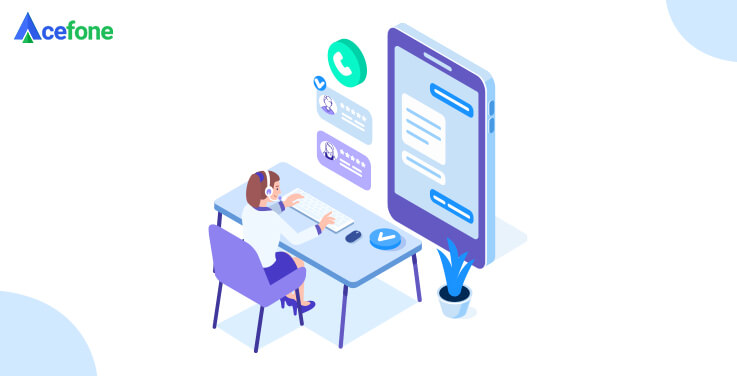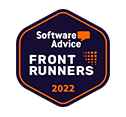Call centers have emerged as a key touchpoint for businesses in India. They enable establishing contact with customers, understanding their demands, and offer quick and efficient solutions.
Though a typical call center phone system’s setup reminds us of long call queues and frustrated customers, the modern-day industry has become increasingly streamlined. Backed by cloud-based call center phone systems, businesses can now offer contextual customer experiences in an organized manner. The global contact center market is expected to grow at a CAGR of 24% by 2030, reaching up to $148 Billion.
Why this rapid growth?
Call center phone systems come with a variety of cardinal features, helping businesses of all sizes communicate efficiently. Considering the rapid digitization of business communication services in recent time, companies are switching to call center phone systems faster than ever.
Must Have Call Center System Features You Need

Smiling young call center agent conversing with customer.
To ensure that your business meets customer expectations, here are the top 10 must have call center system features.
-
Interactive Voice Response
Interactive Voice Response (IVR) systems enable customers to navigate to the concerned customer service agent. The IVR system presents a set of options to the customer in the form of an in-call menu. The customer chooses the concerned department by hitting the corresponding button from the IVR in-call menu.
You can create an IVR flow that allows customers to:
- Press 1 to get the latest product information
- Press 2 to connect with the billing department
- Press 3 to talk to a support agent
Acefone offers you a Multi-level IVR that presents a series of branched questions to understand the root of your concern before connecting you to an agent. Those questions help the IVR system determine whether the pre-defined answers will suffice, or the customer should be connected to an agent.
-
Automated Call Distribution
The Auto Call Distribution aids in routing incoming calls to the appropriate destination in a call center phone system. It intelligently routes calls based on set criteria such as caller ID, working hours, support level, and IVR selection.
The ACD systems acts as an equaliser for businesses aiming to balance workload among their agents. By implementing the ACD feature into your call center phone system, you prevent agents from performance burnout and maintain their productivity.
-
Call Monitoring
Call monitoring is crucial part of a call center phone system. It allows managers and supervisors to observe conversations in real time, utilising them as reference material to train recruits. It also allows stakeholders to monitor the department’s overall progress, track KPIs, and device strategies to improve customer experience.
Call monitoring in a vital call center system feature that involves call whispering and call barging. These two functionalities allow supervisors to jump on to live calls and assist in query resolution.
Call whispering allows supervisors to join and assist agents in providing a relevant solution without letting the customer know. On the contrary, call barging enables supervisors to take over the call and deliver a solution themselves.
-
Skill-based Routing
Customer service agents work based on their expertise. They are categorised depending on their experience, languages known, and skillset. Skill-based routing is a call center system feature that enables directing customers to the most appropriate customer service agent for specific instances.
Consider an example of a French-speaking customer who has contacted the call center for assistance about network issues. Connecting him with a non-technical Chinese speaking agent will result in poor customer experience. Skill-based routing eliminates such a scenario and empowers seamless routing.
-
Preview Dialers
Preview dialers in a call center phone system allow agents to review customer information before initiating calls manually. You’ll be surprised to know that sales agents spend almost 65% of their time on administrative work, sidelining their priority tasks. Preview dialers enable agents to dedicate their energy towards more ROI centric activities than administrative work.
They foster personalized interactions and ensures agents are well-prepared for each conversation. Preview dialers are particularly useful for handling complex or high value leads where customization and individual attention are essential.
Additionally, Preview Dialers offer flexibility and control to agents, empowering them to prioritize calls based on customer profiles and preferences. Such capabilities ultimately improve the call center’s overall efficiency and performance.

-
Live Call Transfer
The live call transfer feature is another handy tool for a call center phone system, enabling agents to transfer calls to other agents, supervisors, or an IVR without disconnecting.
To successfully transfer an ongoing call, the current agent takes the customer’s consent and initiates a call transfer request through the portal. The corresponding agent/ supervisor receives the request, given they are available. The current agent then briefs them about the case, while the customers wait on hold.
Post briefing the customer is then connected to the new agent/ supervisor and the call continues from there. The live transfer saves both parties abundant time as the customer needn’t connect over a new call to discuss their issues. It acts as a bridging tool in a call center system ensuring agents can provide the most relevant solution to customers.
-
Voicemail to Email
The use of Voicemail-to-email in call center phone system offers significant advantages for agents and contributes to departmental progress. Call center agents can receive voicemails directly in their email inbox, ensuring prompt responses to customer inquiries.
It comes handy when agents miss the customer’s initial call. This convenience and flexibility empower agents to stay connected and address customer needs from any location.
Acefone’s Voicemail-to-email feature facilitates efficient documentation and follow-up on customer cases. Agents can easily archive and review voicemail recordings for accurate tracking and query resolution.
Additionally, call center systems can leverage voicemail data for performance monitoring and analysis, driving consistent improvement in agent performance and overall departmental processes.
-
CRM Integration
Almost every call center phone system involves a CRM integration in place to help agents deliver personalised experiences. The technology provides agents with information like customer name, ticket type, chat transcripts etc.
Such vital information helps agents work in an efficient and organised manner and provide relevant solutions to customers, ensuring higher CSAT levels. Acefone offers CRM integration with a pool of industry leading platforms. Some of the call center phone system’s integrations include Microsoft Teams, Pipedrive, Zoho, Salesforce, and HubSpot.
Users can add any of the available integrations at Acefone with a simple toggle provided on the call center phone system’s portal. Once turned on, the integration becomes active and is ready for use across any of the user’s registered devices.
-
Real-Time Call Monitoring
Real-time monitoring provides detailed insights into agent-customer interactions and several service level metrics. Some of these metrics include average call waiting time, maximum waiting time, average handling time, and the average number of agents available.
Real-time call monitoring helps stakeholders make informed decisions on par with the organisation’s objectives. The information can also be used to make strategic decisions, boost call center phone system efficiency, and customer experiences.
-
Reporting and Analytics
Call reporting capabilities help call center systems make data-driven decisions. It has a significant impact on the organisation as it enables supervisors to view performance levels on an intrinsic as well as overall depth. Managers and stakeholders can monitor agent performances, evaluate call quality, identify potential bottlenecks, and contribute towards the overall process improvement.
Acefone’s analytical data provides its users a closer look at their team’s workload and helps them identify deviations simultaneously. This call center system feature helps them make effective staffing decisions in the long run.
In a Nutshell
Call center phone systems are not restricted to features like call forwarding and recording. They have grown enormously by adopting state-of-the-art capabilities like real time analytics, auto dialers, IVR, live chat, and CRM integration.
These technological advancements have contributed immensely to the smooth functioning of call center systems. We hope the above-mentioned points provide a detailed view of a call center phone system’s capabilities and how they help in improving business efficiency.
If you find these features helpful and think that they might help you streamline your business communications, feel free to get in touch with our experts for a free trial.


Ritwik is a fitness enthusiast with a bachelor’s degree in computer applications. He discovered his passion for storytelling while writing articles for his fitness blog. After which, he decided to switch to full-time writing, exploring his capabilities as a professional writer. He is now practicing his skills as a senior content writer at Acefone Software pvt ltd. to bring words to life.











